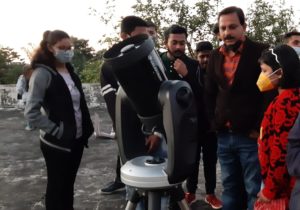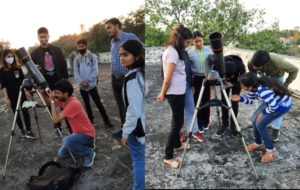Barak UpdatesHappeningsBreaking News
Dept. of Physics, Assam University organises night sky viewing camp of ‘Winter Solstice’

Dec. 21: Skywatchers around the globe were gearing up to watch a rare spectacular event in the evening sky on December 21, when two bright planets — Jupiter and Saturn — came in close conjunction after 367 years, the first such event since 1623 and nearly 800 years after the alignment of Saturn and Jupiter occurred at night.
 The planets were separated by just 0.1 degrees. The planets regularly appear to pass each other in the solar system, with the positions of Jupiter and Saturn being aligned in the sky about once every 20 years. It is the Northern Hemisphere’s first day of winter as well as this rare double planet sighting- or “Great Conjunction”- which can be viewed from anywhere around the globe!” It is believed that, after the solstice, the days get longer and the nights get shorter.
The planets were separated by just 0.1 degrees. The planets regularly appear to pass each other in the solar system, with the positions of Jupiter and Saturn being aligned in the sky about once every 20 years. It is the Northern Hemisphere’s first day of winter as well as this rare double planet sighting- or “Great Conjunction”- which can be viewed from anywhere around the globe!” It is believed that, after the solstice, the days get longer and the nights get shorter.
 What makes this year’s spectacle so rare, then? It’s been nearly 400 years since the planets passed this close to each other in the sky, and nearly 800 years since the alignment of Saturn and Jupiter occurred at night, as it will for 2020, allowing nearly everyone around the world to witness this “great conjunction.”
What makes this year’s spectacle so rare, then? It’s been nearly 400 years since the planets passed this close to each other in the sky, and nearly 800 years since the alignment of Saturn and Jupiter occurred at night, as it will for 2020, allowing nearly everyone around the world to witness this “great conjunction.”
 The Department of Physics, Assam University, Silchar in association with the Barak Astronomy Club organized a Night Sky Viewing Camp using 4 inches and 8 inches Telescope to view this rare event on December 21, 2020 at the University campus. Faculty, students and some local people were a part of this historical moment.
The Department of Physics, Assam University, Silchar in association with the Barak Astronomy Club organized a Night Sky Viewing Camp using 4 inches and 8 inches Telescope to view this rare event on December 21, 2020 at the University campus. Faculty, students and some local people were a part of this historical moment.
 Expressing his views, Dr. Himadri Sekhar Das, Assistant Professor of the Department of Physics who organised the night sky viewing camp maintaining Covid-19 said, “The two planets Jupiter and Saturn come close to the extent that they are separated by just one-tenth of a degree. This is the closest moment that these two planets have been recorded since 1623 which was only after more than a decade telescope was invented. After almost four centuries, they came this close to each other.”
Expressing his views, Dr. Himadri Sekhar Das, Assistant Professor of the Department of Physics who organised the night sky viewing camp maintaining Covid-19 said, “The two planets Jupiter and Saturn come close to the extent that they are separated by just one-tenth of a degree. This is the closest moment that these two planets have been recorded since 1623 which was only after more than a decade telescope was invented. After almost four centuries, they came this close to each other.”
“We also captured photos using Celestron 8″ Cassegrain Telescope. It was a memorable day indeed for our department,” Dr. Das added.





